Watched September 3 - 9, 2007: Nomura and Senbon
Harikomi / The Stakeout (Yoshitaro Nomura, 1958)
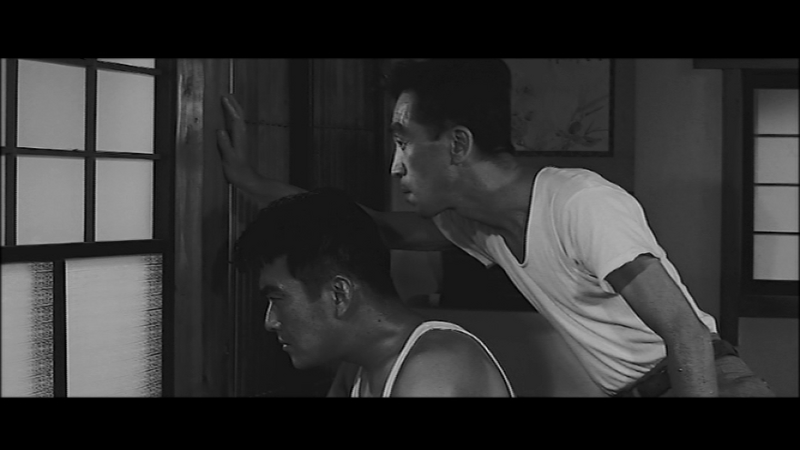 A couple of years ago, I saw (and liked quite a lot) the two Nomura films released on DVD by HVE -- Zero no shoten (Zero Focus, 1961) and Kichiku (The Demon, 1978). I kept hoping for subbed DVDs of more of his films, but none ever appeared. Consequently, when Shochiku re-issued a number of his films at bargain prices (for Japan), I decided to try out a few more -- despite the lack of subtitles. The purchase of this film turns out to have been a wise move. Like Zero Focus, this features superb black and white Cinemascope-style cinematography and a first rate cast of veteran stars. Like both these other films, Harikomi is based on a detective story by Seicho Matumoto.
A couple of years ago, I saw (and liked quite a lot) the two Nomura films released on DVD by HVE -- Zero no shoten (Zero Focus, 1961) and Kichiku (The Demon, 1978). I kept hoping for subbed DVDs of more of his films, but none ever appeared. Consequently, when Shochiku re-issued a number of his films at bargain prices (for Japan), I decided to try out a few more -- despite the lack of subtitles. The purchase of this film turns out to have been a wise move. Like Zero Focus, this features superb black and white Cinemascope-style cinematography and a first rate cast of veteran stars. Like both these other films, Harikomi is based on a detective story by Seicho Matumoto.
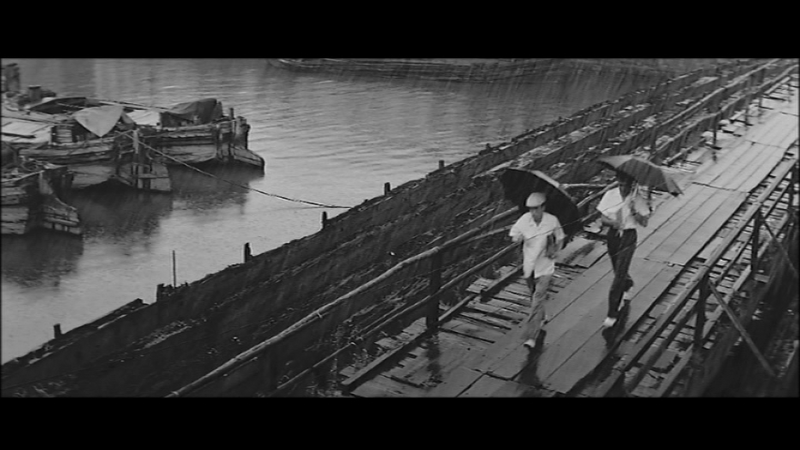 As with Kurosawa's Nora inu (Stray Dog, 1949), Harikomi involves a veteran policeman (Seiji Miyaguchi) and a junior associate (Minoru Ohki) trying to capture a malefactor during an oppressively hot summer. Here, however, the focus is not so much on searching -- but on waiting and watching. Their fugitive has fled Tokyo, leaving no real trail. For lack of any better options, the two officers travel to the town in Kyushu in which the criminal's former girl friend (Hideko Takmine) lives.
As with Kurosawa's Nora inu (Stray Dog, 1949), Harikomi involves a veteran policeman (Seiji Miyaguchi) and a junior associate (Minoru Ohki) trying to capture a malefactor during an oppressively hot summer. Here, however, the focus is not so much on searching -- but on waiting and watching. Their fugitive has fled Tokyo, leaving no real trail. For lack of any better options, the two officers travel to the town in Kyushu in which the criminal's former girl friend (Hideko Takmine) lives. 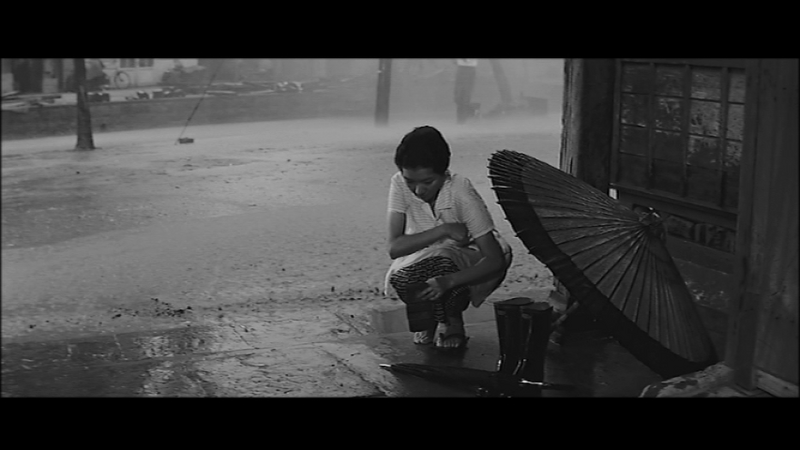 Once in Kyushu, they rent a room in an inn across the street from Takamine's home. While watching Takamine's day to day life, they grow increasing sympathetic of her plight -- she is married to a rather boorish banker and has a bunch of demanding children. She not only has to do all the housework unaided, but also has to take on extra chores to help pay household expenses (her husband being quite stingy). The apparent idleness of the two detectives leads to lots of speculation (and a bit of merriment) among the inn's staff (led by proprietress Kumeko Urabe).
Once in Kyushu, they rent a room in an inn across the street from Takamine's home. While watching Takamine's day to day life, they grow increasing sympathetic of her plight -- she is married to a rather boorish banker and has a bunch of demanding children. She not only has to do all the housework unaided, but also has to take on extra chores to help pay household expenses (her husband being quite stingy). The apparent idleness of the two detectives leads to lots of speculation (and a bit of merriment) among the inn's staff (led by proprietress Kumeko Urabe).
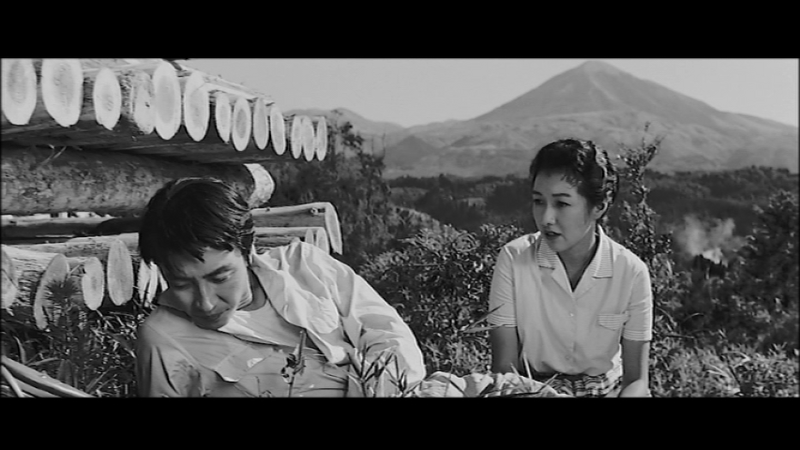 The detectives are not always idle, however -- sometimes they chase after Takamine on false alarms, such as shopping trips or a visit to a funeral in a rural village. Eventually, because this lead has proved so unpromising, the senior detective returns to Tokyo. One day, Takamine gets a letter that changes her demeanor -- and eventually she sets off on a journey alone (except for Ohki tailing her). She finally does rendezvous with her former lover, still unaware of his legal problems. As they go together to a resort inn, Ohki gathers local reinforcements...
The detectives are not always idle, however -- sometimes they chase after Takamine on false alarms, such as shopping trips or a visit to a funeral in a rural village. Eventually, because this lead has proved so unpromising, the senior detective returns to Tokyo. One day, Takamine gets a letter that changes her demeanor -- and eventually she sets off on a journey alone (except for Ohki tailing her). She finally does rendezvous with her former lover, still unaware of his legal problems. As they go together to a resort inn, Ohki gathers local reinforcements...
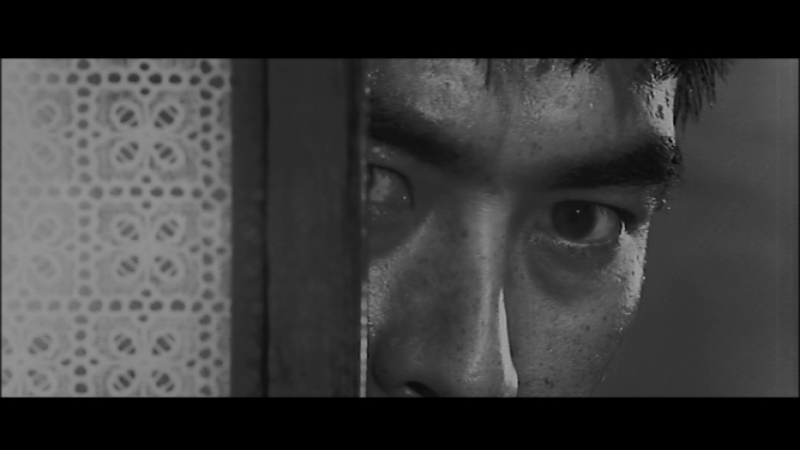 This film focuses almost entirely on the police detectives. Takamine and her former lover are seen only as they are seen by their observers. This is no flaw in this case, but the concern is with the impact of the pursuit on the pursuers -- and not on the unwary prey. It is unfortunate that no subbed version is available, as Harikomi is at least as fine a film as the two Nomura ones that are available on DVD in the United States. Highly recommended.
This film focuses almost entirely on the police detectives. Takamine and her former lover are seen only as they are seen by their observers. This is no flaw in this case, but the concern is with the impact of the pursuit on the pursuers -- and not on the unwary prey. It is unfortunate that no subbed version is available, as Harikomi is at least as fine a film as the two Nomura ones that are available on DVD in the United States. Highly recommended.
More screen shots:
http://i9.photobucket.com/albums/a59/mkerpan/nomura/harikomi01.png
http://i9.photobucket.com/albums/a59/mkerpan/nomura/harikomi02.png
http://i9.photobucket.com/albums/a59/mkerpan/nomura/harikomi04.png
http://i9.photobucket.com/albums/a59/mkerpan/nomura/harikomi05.png
http://i9.photobucket.com/albums/a59/mkerpan/nomura/harikomi07.png
http://i9.photobucket.com/albums/a59/mkerpan/nomura/harikomi08.png
http://i9.photobucket.com/albums/a59/mkerpan/nomura/harikomi09.png
http://i9.photobucket.com/albums/a59/mkerpan/nomura/harikomi11.png
http://i9.photobucket.com/albums/a59/mkerpan/nomura/harikomi12.png
http://i9.photobucket.com/albums/a59/mkerpan/nomura/harikomi14.png
http://i9.photobucket.com/albums/a59/mkerpan/nomura/harikomi15.png
http://i9.photobucket.com/albums/a59/mkerpan/nomura/harikomi16.png
http://i9.photobucket.com/albums/a59/mkerpan/nomura/harikomi18.png
http://i9.photobucket.com/albums/a59/mkerpan/nomura/harikomi19.png
http://i9.photobucket.com/albums/a59/mkerpan/nomura/harikomi20.png
Kage no kuruma / The Shadow Within (Yoshitaro Nomura, 1970)
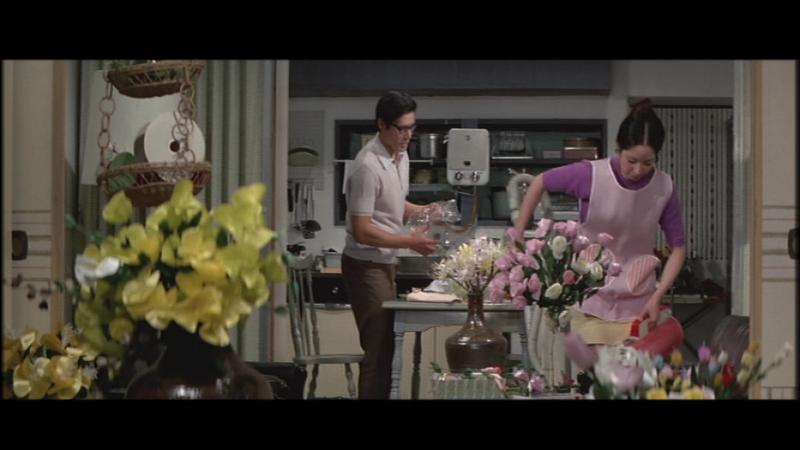 This fourth Nomura film proved to be not quite so satisfactory as the three I had seen previously. The visual clarity found in the other films was marred here by instances of cinematic gimmickry -- such as split screen images and flashbacks involving deconstructed (decomposed?) color. The flashbacks looked rather gruesome when watched on our television, but not quite so bad when viewed on a computer monitor. The script also had some problems.
This fourth Nomura film proved to be not quite so satisfactory as the three I had seen previously. The visual clarity found in the other films was marred here by instances of cinematic gimmickry -- such as split screen images and flashbacks involving deconstructed (decomposed?) color. The flashbacks looked rather gruesome when watched on our television, but not quite so bad when viewed on a computer monitor. The script also had some problems.
 The story concept here (once again based on a story by Seicho Matsumoto) is relatively intriguing. The protagonist (Go Kato) is a mild-mannered travel agent married to a rather ditzy wife (Mayumi Ogawa) who is always involved with hobbies and socializing with friends. One day, while riding the bus home from work, he runs across his childhood sweetheart (Shima Iwashita).
The story concept here (once again based on a story by Seicho Matsumoto) is relatively intriguing. The protagonist (Go Kato) is a mild-mannered travel agent married to a rather ditzy wife (Mayumi Ogawa) who is always involved with hobbies and socializing with friends. One day, while riding the bus home from work, he runs across his childhood sweetheart (Shima Iwashita). 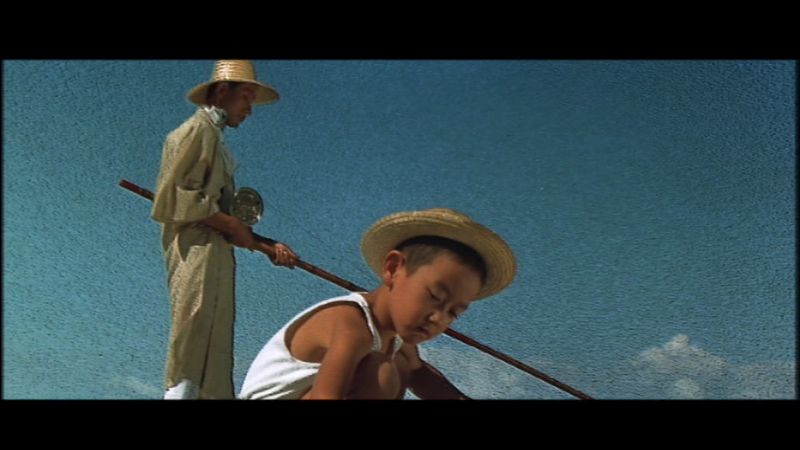 A few days later, he visits her home -- and meets her 6 year old son. At first all goes "well". Kato's romance with Iwashita progresses, he bonds with her son -- and his wife is too preoccupied to think much about the fact that he is working later than ever before. But when the three go on a car trip to a wilderness park, the boy gets upset. After the adults slip off to make love while the boy is asleep in the car, he wakes up and is unable to find anyone, despiting searching and calling. After this point, accidents happen when Kato visits -- and he thinks the boy is trying to injure or kill him.
A few days later, he visits her home -- and meets her 6 year old son. At first all goes "well". Kato's romance with Iwashita progresses, he bonds with her son -- and his wife is too preoccupied to think much about the fact that he is working later than ever before. But when the three go on a car trip to a wilderness park, the boy gets upset. After the adults slip off to make love while the boy is asleep in the car, he wakes up and is unable to find anyone, despiting searching and calling. After this point, accidents happen when Kato visits -- and he thinks the boy is trying to injure or kill him.
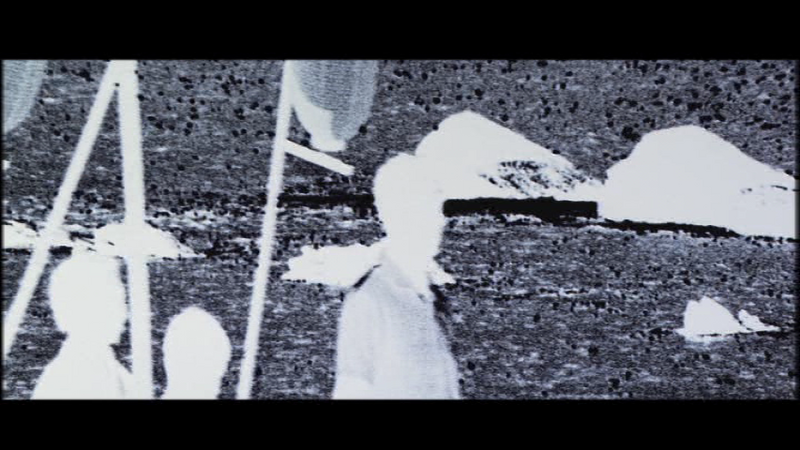 Intercut with the present-days scenes, Nomura presents Kato's memories of his own childhood, including ones involving his step-father. It seems Kato was very jealous of his widowed mother, and resented his new step-parent (despite reasonably decent treatment). As the film progresses, it becomes clear that Kato sees parallels between his childhood self and the young son of his lover. Eventually, this leads to real problems for all...
Intercut with the present-days scenes, Nomura presents Kato's memories of his own childhood, including ones involving his step-father. It seems Kato was very jealous of his widowed mother, and resented his new step-parent (despite reasonably decent treatment). As the film progresses, it becomes clear that Kato sees parallels between his childhood self and the young son of his lover. Eventually, this leads to real problems for all...
 The primary problem in this film is an almost total psychological disconnect between the protagonist's childhood persona and his contemporary one. The focus in this film is on his personality -- yet there is no hint as to how the surly, violent child turned into the nebbishy travel agent we saw at the film's start. Perhaps having subtitles would have helped a bit, but the visual foundations of the film struck me as a bit muddled. An interesting film, and worth seeing -- but not on the level of Nomura's best work.
The primary problem in this film is an almost total psychological disconnect between the protagonist's childhood persona and his contemporary one. The focus in this film is on his personality -- yet there is no hint as to how the surly, violent child turned into the nebbishy travel agent we saw at the film's start. Perhaps having subtitles would have helped a bit, but the visual foundations of the film struck me as a bit muddled. An interesting film, and worth seeing -- but not on the level of Nomura's best work.
http://i9.photobucket.com/albums/a59/mkerpan/nomura/kage02.png
http://i9.photobucket.com/albums/a59/mkerpan/nomura/kage04.png
http://i9.photobucket.com/albums/a59/mkerpan/nomura/kage06.png
http://i9.photobucket.com/albums/a59/mkerpan/nomura/kage09.png
http://i9.photobucket.com/albums/a59/mkerpan/nomura/kage10.png
http://i9.photobucket.com/albums/a59/mkerpan/nomura/kage13.png
Akai Kujira to Shiroi Hebi / Red Whale, White Snake (Yoshiko Senbon, 2006)
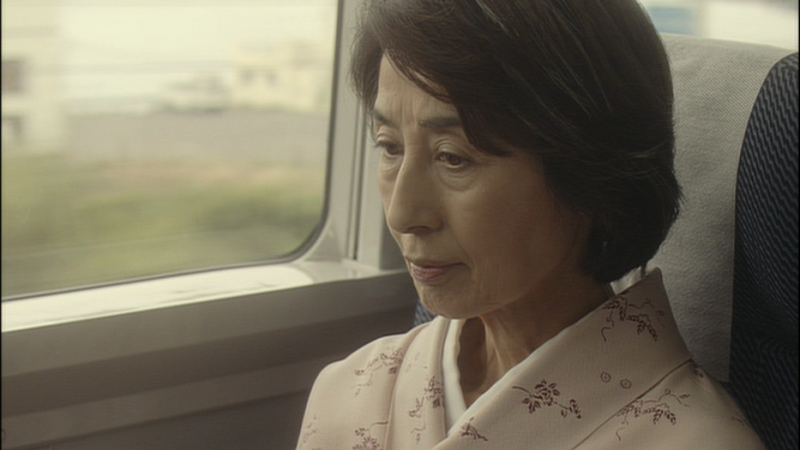 Kyoko Kagawa made her first film around 57 years ago, and -- judging from JMDB (which is not quite up to date) -- her appearance in this film would appear to be about her 120th role. Here, playing an elderly woman in the early stage of senile dementia, she shows that she remains one of the world's finest actresses. Here she works with Yoshiko Senbon, a retired television director (who began working in Japan's television industry in 1953) making her first feature film. All in all, this all-woman (for all practical purposes) film is a quite satisfactory one.
Kyoko Kagawa made her first film around 57 years ago, and -- judging from JMDB (which is not quite up to date) -- her appearance in this film would appear to be about her 120th role. Here, playing an elderly woman in the early stage of senile dementia, she shows that she remains one of the world's finest actresses. Here she works with Yoshiko Senbon, a retired television director (who began working in Japan's television industry in 1953) making her first feature film. All in all, this all-woman (for all practical purposes) film is a quite satisfactory one.
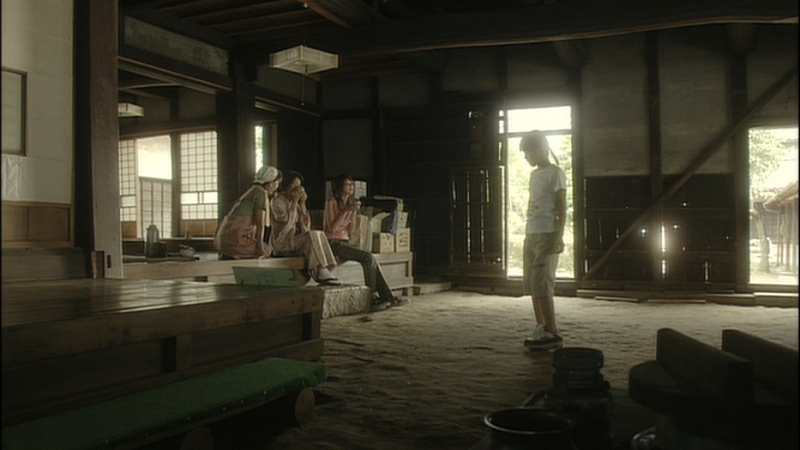 At the outset, Yasue (Kagawa) is shown riding in a train with Akemi, one of her grand-daughters, a 20-something Tokyo-ite (Mao Miyaji). Because of her increasing bouts of disorientation and memory loss, Yasue's family has decided she should finally move in with one of her children. As the two are on their way, the train stops at a station in the town in which Yasue spent part of her teen years in, as a refugee from the ongoing bombing of Tokyo.
At the outset, Yasue (Kagawa) is shown riding in a train with Akemi, one of her grand-daughters, a 20-something Tokyo-ite (Mao Miyaji). Because of her increasing bouts of disorientation and memory loss, Yasue's family has decided she should finally move in with one of her children. As the two are on their way, the train stops at a station in the town in which Yasue spent part of her teen years in, as a refugee from the ongoing bombing of Tokyo. 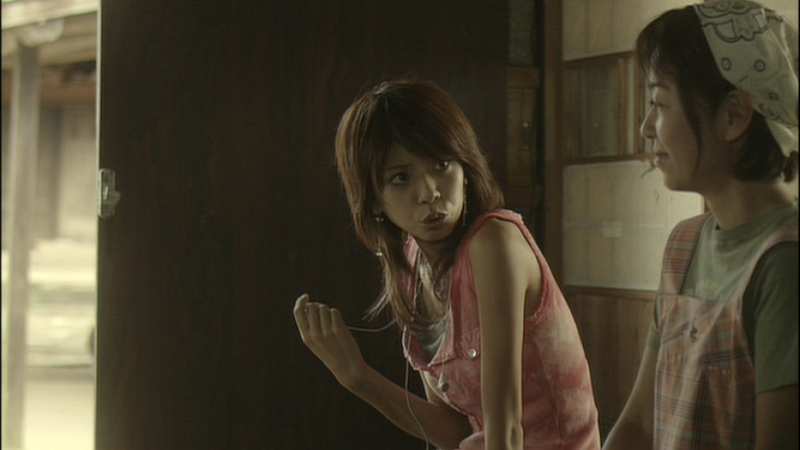 Hearing the name announced triggers a desire to see this place again. So the pair set out via taxi to find the old farm house, guided only by Yasue's decades old memories -- which prove to still be dependable. As it turns out, the house Yasue seeks is still there, but not for long. It is currently occupied by Mitsuko (Miyoko Asada) and her daughter (a fifth grader, played by 11 year-old Mari Banno in her first film role).
Hearing the name announced triggers a desire to see this place again. So the pair set out via taxi to find the old farm house, guided only by Yasue's decades old memories -- which prove to still be dependable. As it turns out, the house Yasue seeks is still there, but not for long. It is currently occupied by Mitsuko (Miyoko Asada) and her daughter (a fifth grader, played by 11 year-old Mari Banno in her first film role). 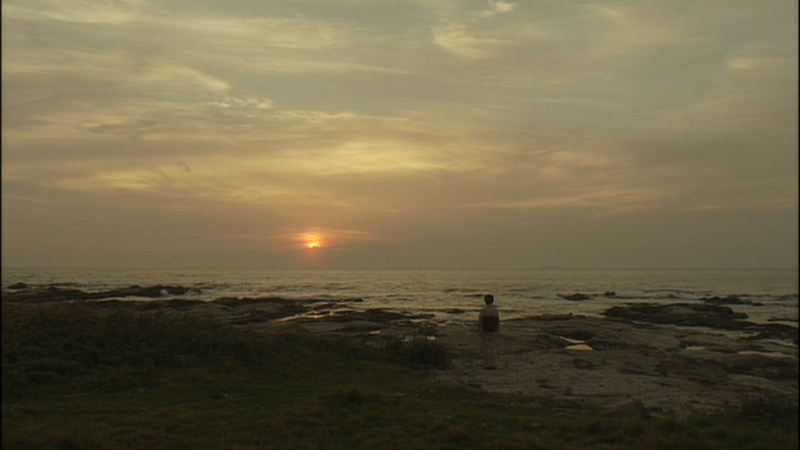 Mitsuko, whose husband had deserted the family three years earlier, has decided to have the old farm complex torn down soon in order to build a modern house (her daughter is unhappy about this plan, as the house is filled with memories of happier days with her father). Yasue asks to be allowed to stay the night, to the mortification of her grand-daughter and Mitsuko cheerily invites the two to make themselves at home for as long as they wish.
Mitsuko, whose husband had deserted the family three years earlier, has decided to have the old farm complex torn down soon in order to build a modern house (her daughter is unhappy about this plan, as the house is filled with memories of happier days with her father). Yasue asks to be allowed to stay the night, to the mortification of her grand-daughter and Mitsuko cheerily invites the two to make themselves at home for as long as they wish.
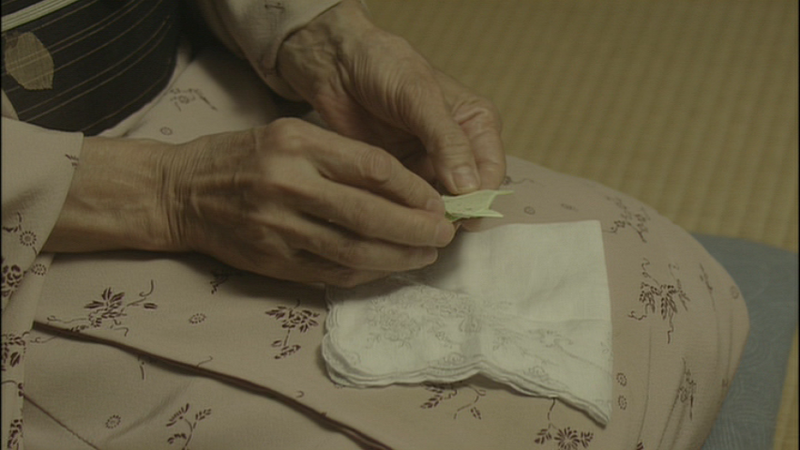 As it turns out, Kagawa has a stronger reason to visit the old house than simple nostalgia. She has begun to recall a vow she made to the young man she fell in love with while living there. He too was an evacuee, but he was alone in the world, having lost his entire family due to bombing.
As it turns out, Kagawa has a stronger reason to visit the old house than simple nostalgia. She has begun to recall a vow she made to the young man she fell in love with while living there. He too was an evacuee, but he was alone in the world, having lost his entire family due to bombing.  When he was drafted, he asked Kagawa to always remember him in the event of his death, as she would be the only one who could preserve his memory. Visiting the house also revives her memory of a magical white snake (capable of bringing fortune to those who see it) who lived near the house. While others are skeptical, young Rika is fascinated.
When he was drafted, he asked Kagawa to always remember him in the event of his death, as she would be the only one who could preserve his memory. Visiting the house also revives her memory of a magical white snake (capable of bringing fortune to those who see it) who lived near the house. While others are skeptical, young Rika is fascinated.
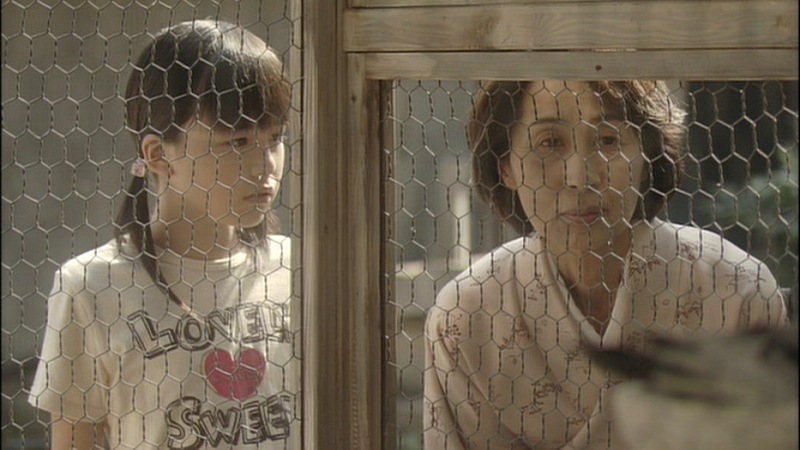 The four women are joined soon after by a fifth -- Midori (Kirin Kiki), a previous owner of the house. Midori proves to be quite interested in the private lives of the other women, but very reticent about her own (she seems to be involved with some chicanery involving the marketing of diet supplements). During their stay, Yasue remembers that she was supposed to find a box hidden away by her young friend before his departure --
The four women are joined soon after by a fifth -- Midori (Kirin Kiki), a previous owner of the house. Midori proves to be quite interested in the private lives of the other women, but very reticent about her own (she seems to be involved with some chicanery involving the marketing of diet supplements). During their stay, Yasue remembers that she was supposed to find a box hidden away by her young friend before his departure --  and Rika helps Yasue look for the fabled white snake. Meanwhile, Akemi is having troubles of her own -- she turns out to be pregnant and her boy friend in Tokyo isn't the least bit interested in discussing the issue (to the extent of refusing to accept her calls). The remainder of the film (all the way through a long shot embedded in the midst of the credits) involves the working out of the five women's dilemmas.
and Rika helps Yasue look for the fabled white snake. Meanwhile, Akemi is having troubles of her own -- she turns out to be pregnant and her boy friend in Tokyo isn't the least bit interested in discussing the issue (to the extent of refusing to accept her calls). The remainder of the film (all the way through a long shot embedded in the midst of the credits) involves the working out of the five women's dilemmas.
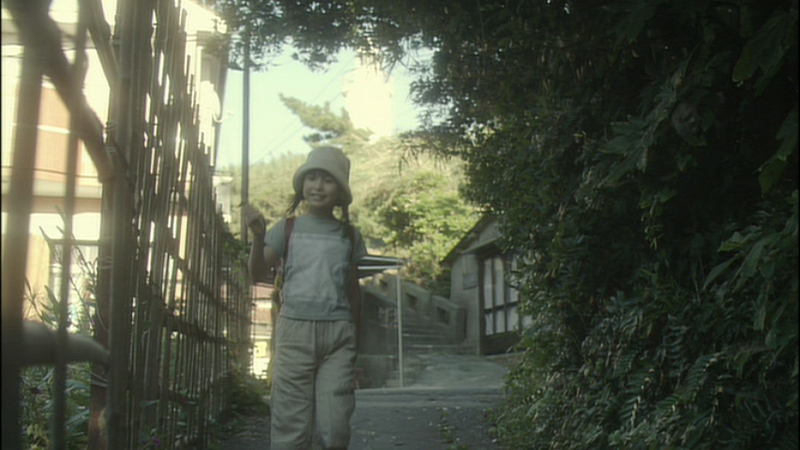 A tangent. This is yet another modern Asian film that presents, in passing, a school girl's onset of menstrutation. The event is not treated casually, but is simply shown as an ordinary bit of life to be dealt with. So far as I can tell, this topic is virtually taboo in North American cinema, except in the context of horror films (viz. Carrie and Ginger Snaps). Make of this what you will.
A tangent. This is yet another modern Asian film that presents, in passing, a school girl's onset of menstrutation. The event is not treated casually, but is simply shown as an ordinary bit of life to be dealt with. So far as I can tell, this topic is virtually taboo in North American cinema, except in the context of horror films (viz. Carrie and Ginger Snaps). Make of this what you will.
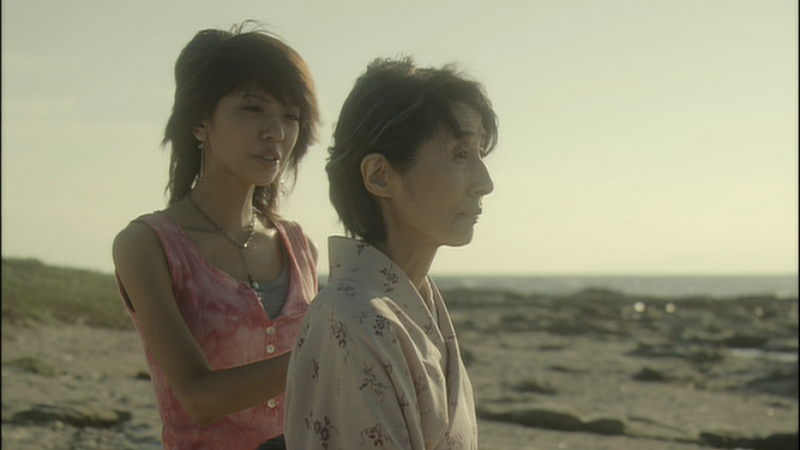 The Japanese DVD of this film looks good, but is (as is too often the case) unsubtitled. I actually watched this twice -- and found things much easier to follow the second time through. I suspect this film might be too culturally and historically specific to ever make it into Western theaters. It's our loss. While hardly an overwhelming film, it si a lovely one with fine performances that tells us something about Japanese life and history that we are unlikely to encounter elsewhere.
The Japanese DVD of this film looks good, but is (as is too often the case) unsubtitled. I actually watched this twice -- and found things much easier to follow the second time through. I suspect this film might be too culturally and historically specific to ever make it into Western theaters. It's our loss. While hardly an overwhelming film, it si a lovely one with fine performances that tells us something about Japanese life and history that we are unlikely to encounter elsewhere.
 A couple of years ago, I saw (and liked quite a lot) the two Nomura films released on DVD by HVE -- Zero no shoten (Zero Focus, 1961) and Kichiku (The Demon, 1978). I kept hoping for subbed DVDs of more of his films, but none ever appeared. Consequently, when Shochiku re-issued a number of his films at bargain prices (for Japan), I decided to try out a few more -- despite the lack of subtitles. The purchase of this film turns out to have been a wise move. Like Zero Focus, this features superb black and white Cinemascope-style cinematography and a first rate cast of veteran stars. Like both these other films, Harikomi is based on a detective story by Seicho Matumoto.
A couple of years ago, I saw (and liked quite a lot) the two Nomura films released on DVD by HVE -- Zero no shoten (Zero Focus, 1961) and Kichiku (The Demon, 1978). I kept hoping for subbed DVDs of more of his films, but none ever appeared. Consequently, when Shochiku re-issued a number of his films at bargain prices (for Japan), I decided to try out a few more -- despite the lack of subtitles. The purchase of this film turns out to have been a wise move. Like Zero Focus, this features superb black and white Cinemascope-style cinematography and a first rate cast of veteran stars. Like both these other films, Harikomi is based on a detective story by Seicho Matumoto. As with Kurosawa's Nora inu (Stray Dog, 1949), Harikomi involves a veteran policeman (Seiji Miyaguchi) and a junior associate (Minoru Ohki) trying to capture a malefactor during an oppressively hot summer. Here, however, the focus is not so much on searching -- but on waiting and watching. Their fugitive has fled Tokyo, leaving no real trail. For lack of any better options, the two officers travel to the town in Kyushu in which the criminal's former girl friend (Hideko Takmine) lives.
As with Kurosawa's Nora inu (Stray Dog, 1949), Harikomi involves a veteran policeman (Seiji Miyaguchi) and a junior associate (Minoru Ohki) trying to capture a malefactor during an oppressively hot summer. Here, however, the focus is not so much on searching -- but on waiting and watching. Their fugitive has fled Tokyo, leaving no real trail. For lack of any better options, the two officers travel to the town in Kyushu in which the criminal's former girl friend (Hideko Takmine) lives.  Once in Kyushu, they rent a room in an inn across the street from Takamine's home. While watching Takamine's day to day life, they grow increasing sympathetic of her plight -- she is married to a rather boorish banker and has a bunch of demanding children. She not only has to do all the housework unaided, but also has to take on extra chores to help pay household expenses (her husband being quite stingy). The apparent idleness of the two detectives leads to lots of speculation (and a bit of merriment) among the inn's staff (led by proprietress Kumeko Urabe).
Once in Kyushu, they rent a room in an inn across the street from Takamine's home. While watching Takamine's day to day life, they grow increasing sympathetic of her plight -- she is married to a rather boorish banker and has a bunch of demanding children. She not only has to do all the housework unaided, but also has to take on extra chores to help pay household expenses (her husband being quite stingy). The apparent idleness of the two detectives leads to lots of speculation (and a bit of merriment) among the inn's staff (led by proprietress Kumeko Urabe). The detectives are not always idle, however -- sometimes they chase after Takamine on false alarms, such as shopping trips or a visit to a funeral in a rural village. Eventually, because this lead has proved so unpromising, the senior detective returns to Tokyo. One day, Takamine gets a letter that changes her demeanor -- and eventually she sets off on a journey alone (except for Ohki tailing her). She finally does rendezvous with her former lover, still unaware of his legal problems. As they go together to a resort inn, Ohki gathers local reinforcements...
The detectives are not always idle, however -- sometimes they chase after Takamine on false alarms, such as shopping trips or a visit to a funeral in a rural village. Eventually, because this lead has proved so unpromising, the senior detective returns to Tokyo. One day, Takamine gets a letter that changes her demeanor -- and eventually she sets off on a journey alone (except for Ohki tailing her). She finally does rendezvous with her former lover, still unaware of his legal problems. As they go together to a resort inn, Ohki gathers local reinforcements... This film focuses almost entirely on the police detectives. Takamine and her former lover are seen only as they are seen by their observers. This is no flaw in this case, but the concern is with the impact of the pursuit on the pursuers -- and not on the unwary prey. It is unfortunate that no subbed version is available, as Harikomi is at least as fine a film as the two Nomura ones that are available on DVD in the United States. Highly recommended.
This film focuses almost entirely on the police detectives. Takamine and her former lover are seen only as they are seen by their observers. This is no flaw in this case, but the concern is with the impact of the pursuit on the pursuers -- and not on the unwary prey. It is unfortunate that no subbed version is available, as Harikomi is at least as fine a film as the two Nomura ones that are available on DVD in the United States. Highly recommended.More screen shots:
http://i9.photobucket.com/albums/a59/mkerpan/nomura/harikomi01.png
http://i9.photobucket.com/albums/a59/mkerpan/nomura/harikomi02.png
http://i9.photobucket.com/albums/a59/mkerpan/nomura/harikomi04.png
http://i9.photobucket.com/albums/a59/mkerpan/nomura/harikomi05.png
http://i9.photobucket.com/albums/a59/mkerpan/nomura/harikomi07.png
http://i9.photobucket.com/albums/a59/mkerpan/nomura/harikomi08.png
http://i9.photobucket.com/albums/a59/mkerpan/nomura/harikomi09.png
http://i9.photobucket.com/albums/a59/mkerpan/nomura/harikomi11.png
http://i9.photobucket.com/albums/a59/mkerpan/nomura/harikomi12.png
http://i9.photobucket.com/albums/a59/mkerpan/nomura/harikomi14.png
http://i9.photobucket.com/albums/a59/mkerpan/nomura/harikomi15.png
http://i9.photobucket.com/albums/a59/mkerpan/nomura/harikomi16.png
http://i9.photobucket.com/albums/a59/mkerpan/nomura/harikomi18.png
http://i9.photobucket.com/albums/a59/mkerpan/nomura/harikomi19.png
http://i9.photobucket.com/albums/a59/mkerpan/nomura/harikomi20.png
Kage no kuruma / The Shadow Within (Yoshitaro Nomura, 1970)
 This fourth Nomura film proved to be not quite so satisfactory as the three I had seen previously. The visual clarity found in the other films was marred here by instances of cinematic gimmickry -- such as split screen images and flashbacks involving deconstructed (decomposed?) color. The flashbacks looked rather gruesome when watched on our television, but not quite so bad when viewed on a computer monitor. The script also had some problems.
This fourth Nomura film proved to be not quite so satisfactory as the three I had seen previously. The visual clarity found in the other films was marred here by instances of cinematic gimmickry -- such as split screen images and flashbacks involving deconstructed (decomposed?) color. The flashbacks looked rather gruesome when watched on our television, but not quite so bad when viewed on a computer monitor. The script also had some problems. The story concept here (once again based on a story by Seicho Matsumoto) is relatively intriguing. The protagonist (Go Kato) is a mild-mannered travel agent married to a rather ditzy wife (Mayumi Ogawa) who is always involved with hobbies and socializing with friends. One day, while riding the bus home from work, he runs across his childhood sweetheart (Shima Iwashita).
The story concept here (once again based on a story by Seicho Matsumoto) is relatively intriguing. The protagonist (Go Kato) is a mild-mannered travel agent married to a rather ditzy wife (Mayumi Ogawa) who is always involved with hobbies and socializing with friends. One day, while riding the bus home from work, he runs across his childhood sweetheart (Shima Iwashita).  A few days later, he visits her home -- and meets her 6 year old son. At first all goes "well". Kato's romance with Iwashita progresses, he bonds with her son -- and his wife is too preoccupied to think much about the fact that he is working later than ever before. But when the three go on a car trip to a wilderness park, the boy gets upset. After the adults slip off to make love while the boy is asleep in the car, he wakes up and is unable to find anyone, despiting searching and calling. After this point, accidents happen when Kato visits -- and he thinks the boy is trying to injure or kill him.
A few days later, he visits her home -- and meets her 6 year old son. At first all goes "well". Kato's romance with Iwashita progresses, he bonds with her son -- and his wife is too preoccupied to think much about the fact that he is working later than ever before. But when the three go on a car trip to a wilderness park, the boy gets upset. After the adults slip off to make love while the boy is asleep in the car, he wakes up and is unable to find anyone, despiting searching and calling. After this point, accidents happen when Kato visits -- and he thinks the boy is trying to injure or kill him. Intercut with the present-days scenes, Nomura presents Kato's memories of his own childhood, including ones involving his step-father. It seems Kato was very jealous of his widowed mother, and resented his new step-parent (despite reasonably decent treatment). As the film progresses, it becomes clear that Kato sees parallels between his childhood self and the young son of his lover. Eventually, this leads to real problems for all...
Intercut with the present-days scenes, Nomura presents Kato's memories of his own childhood, including ones involving his step-father. It seems Kato was very jealous of his widowed mother, and resented his new step-parent (despite reasonably decent treatment). As the film progresses, it becomes clear that Kato sees parallels between his childhood self and the young son of his lover. Eventually, this leads to real problems for all... The primary problem in this film is an almost total psychological disconnect between the protagonist's childhood persona and his contemporary one. The focus in this film is on his personality -- yet there is no hint as to how the surly, violent child turned into the nebbishy travel agent we saw at the film's start. Perhaps having subtitles would have helped a bit, but the visual foundations of the film struck me as a bit muddled. An interesting film, and worth seeing -- but not on the level of Nomura's best work.
The primary problem in this film is an almost total psychological disconnect between the protagonist's childhood persona and his contemporary one. The focus in this film is on his personality -- yet there is no hint as to how the surly, violent child turned into the nebbishy travel agent we saw at the film's start. Perhaps having subtitles would have helped a bit, but the visual foundations of the film struck me as a bit muddled. An interesting film, and worth seeing -- but not on the level of Nomura's best work.http://i9.photobucket.com/albums/a59/mkerpan/nomura/kage02.png
http://i9.photobucket.com/albums/a59/mkerpan/nomura/kage04.png
http://i9.photobucket.com/albums/a59/mkerpan/nomura/kage06.png
http://i9.photobucket.com/albums/a59/mkerpan/nomura/kage09.png
http://i9.photobucket.com/albums/a59/mkerpan/nomura/kage10.png
http://i9.photobucket.com/albums/a59/mkerpan/nomura/kage13.png
Akai Kujira to Shiroi Hebi / Red Whale, White Snake (Yoshiko Senbon, 2006)
 Kyoko Kagawa made her first film around 57 years ago, and -- judging from JMDB (which is not quite up to date) -- her appearance in this film would appear to be about her 120th role. Here, playing an elderly woman in the early stage of senile dementia, she shows that she remains one of the world's finest actresses. Here she works with Yoshiko Senbon, a retired television director (who began working in Japan's television industry in 1953) making her first feature film. All in all, this all-woman (for all practical purposes) film is a quite satisfactory one.
Kyoko Kagawa made her first film around 57 years ago, and -- judging from JMDB (which is not quite up to date) -- her appearance in this film would appear to be about her 120th role. Here, playing an elderly woman in the early stage of senile dementia, she shows that she remains one of the world's finest actresses. Here she works with Yoshiko Senbon, a retired television director (who began working in Japan's television industry in 1953) making her first feature film. All in all, this all-woman (for all practical purposes) film is a quite satisfactory one. At the outset, Yasue (Kagawa) is shown riding in a train with Akemi, one of her grand-daughters, a 20-something Tokyo-ite (Mao Miyaji). Because of her increasing bouts of disorientation and memory loss, Yasue's family has decided she should finally move in with one of her children. As the two are on their way, the train stops at a station in the town in which Yasue spent part of her teen years in, as a refugee from the ongoing bombing of Tokyo.
At the outset, Yasue (Kagawa) is shown riding in a train with Akemi, one of her grand-daughters, a 20-something Tokyo-ite (Mao Miyaji). Because of her increasing bouts of disorientation and memory loss, Yasue's family has decided she should finally move in with one of her children. As the two are on their way, the train stops at a station in the town in which Yasue spent part of her teen years in, as a refugee from the ongoing bombing of Tokyo.  Hearing the name announced triggers a desire to see this place again. So the pair set out via taxi to find the old farm house, guided only by Yasue's decades old memories -- which prove to still be dependable. As it turns out, the house Yasue seeks is still there, but not for long. It is currently occupied by Mitsuko (Miyoko Asada) and her daughter (a fifth grader, played by 11 year-old Mari Banno in her first film role).
Hearing the name announced triggers a desire to see this place again. So the pair set out via taxi to find the old farm house, guided only by Yasue's decades old memories -- which prove to still be dependable. As it turns out, the house Yasue seeks is still there, but not for long. It is currently occupied by Mitsuko (Miyoko Asada) and her daughter (a fifth grader, played by 11 year-old Mari Banno in her first film role).  Mitsuko, whose husband had deserted the family three years earlier, has decided to have the old farm complex torn down soon in order to build a modern house (her daughter is unhappy about this plan, as the house is filled with memories of happier days with her father). Yasue asks to be allowed to stay the night, to the mortification of her grand-daughter and Mitsuko cheerily invites the two to make themselves at home for as long as they wish.
Mitsuko, whose husband had deserted the family three years earlier, has decided to have the old farm complex torn down soon in order to build a modern house (her daughter is unhappy about this plan, as the house is filled with memories of happier days with her father). Yasue asks to be allowed to stay the night, to the mortification of her grand-daughter and Mitsuko cheerily invites the two to make themselves at home for as long as they wish. As it turns out, Kagawa has a stronger reason to visit the old house than simple nostalgia. She has begun to recall a vow she made to the young man she fell in love with while living there. He too was an evacuee, but he was alone in the world, having lost his entire family due to bombing.
As it turns out, Kagawa has a stronger reason to visit the old house than simple nostalgia. She has begun to recall a vow she made to the young man she fell in love with while living there. He too was an evacuee, but he was alone in the world, having lost his entire family due to bombing.  When he was drafted, he asked Kagawa to always remember him in the event of his death, as she would be the only one who could preserve his memory. Visiting the house also revives her memory of a magical white snake (capable of bringing fortune to those who see it) who lived near the house. While others are skeptical, young Rika is fascinated.
When he was drafted, he asked Kagawa to always remember him in the event of his death, as she would be the only one who could preserve his memory. Visiting the house also revives her memory of a magical white snake (capable of bringing fortune to those who see it) who lived near the house. While others are skeptical, young Rika is fascinated. The four women are joined soon after by a fifth -- Midori (Kirin Kiki), a previous owner of the house. Midori proves to be quite interested in the private lives of the other women, but very reticent about her own (she seems to be involved with some chicanery involving the marketing of diet supplements). During their stay, Yasue remembers that she was supposed to find a box hidden away by her young friend before his departure --
The four women are joined soon after by a fifth -- Midori (Kirin Kiki), a previous owner of the house. Midori proves to be quite interested in the private lives of the other women, but very reticent about her own (she seems to be involved with some chicanery involving the marketing of diet supplements). During their stay, Yasue remembers that she was supposed to find a box hidden away by her young friend before his departure --  and Rika helps Yasue look for the fabled white snake. Meanwhile, Akemi is having troubles of her own -- she turns out to be pregnant and her boy friend in Tokyo isn't the least bit interested in discussing the issue (to the extent of refusing to accept her calls). The remainder of the film (all the way through a long shot embedded in the midst of the credits) involves the working out of the five women's dilemmas.
and Rika helps Yasue look for the fabled white snake. Meanwhile, Akemi is having troubles of her own -- she turns out to be pregnant and her boy friend in Tokyo isn't the least bit interested in discussing the issue (to the extent of refusing to accept her calls). The remainder of the film (all the way through a long shot embedded in the midst of the credits) involves the working out of the five women's dilemmas. A tangent. This is yet another modern Asian film that presents, in passing, a school girl's onset of menstrutation. The event is not treated casually, but is simply shown as an ordinary bit of life to be dealt with. So far as I can tell, this topic is virtually taboo in North American cinema, except in the context of horror films (viz. Carrie and Ginger Snaps). Make of this what you will.
A tangent. This is yet another modern Asian film that presents, in passing, a school girl's onset of menstrutation. The event is not treated casually, but is simply shown as an ordinary bit of life to be dealt with. So far as I can tell, this topic is virtually taboo in North American cinema, except in the context of horror films (viz. Carrie and Ginger Snaps). Make of this what you will. The Japanese DVD of this film looks good, but is (as is too often the case) unsubtitled. I actually watched this twice -- and found things much easier to follow the second time through. I suspect this film might be too culturally and historically specific to ever make it into Western theaters. It's our loss. While hardly an overwhelming film, it si a lovely one with fine performances that tells us something about Japanese life and history that we are unlikely to encounter elsewhere.
The Japanese DVD of this film looks good, but is (as is too often the case) unsubtitled. I actually watched this twice -- and found things much easier to follow the second time through. I suspect this film might be too culturally and historically specific to ever make it into Western theaters. It's our loss. While hardly an overwhelming film, it si a lovely one with fine performances that tells us something about Japanese life and history that we are unlikely to encounter elsewhere.
Comments
Did this get shown as part of the 100 Years of Shochiku retrospective? I was annoyed that not even a bit of this series made it to Boston.